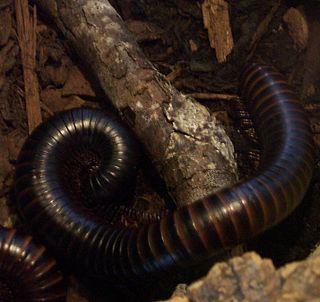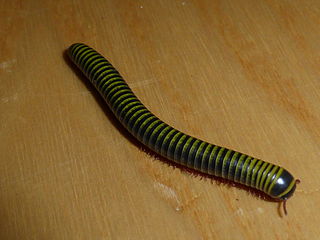Related Research Articles

Lithobius is a large genus of centipedes in the family Lithobiidae, commonly called stone centipedes, common centipedes or brown centipedes.

Polydesmida is the largest order of millipedes, containing approximately 3,500 species, including all the millipedes reported to produce hydrogen cyanide (HCN).

Spirostreptus is a genus of giant millipedes of the family Spirostreptidae. It contains approximately 302 discovered species,listed below: :

Orthoporus is a genus of spirostreptid millipedes, containing around 80 species, distributed from the southern United States to Brazil and Argentina.

Julidae is a family of millipedes in the order Julida, containing more than 600 species in around 20 genera. Its members are largely confined to the Western Palaearctic, with only a few species extending into the Oriental and Afrotropical realms. They are united by a characteristic form of the mouthparts, and are classified in the superfamily Juloidea of the order Julida, alongside the families Trichoblaniulidae, Rhopaloiulidae and Trichonemasomatidae.

Newportia is a genus of scolopocryptopid centipedes. It has around 50 described species to date.

Julus is a genus of millipedes in the family Julidae, containing the following species:

Anadenobolus monilicornis, known as the yellow-banded millipede or bumble bee millipede, is a species of millipede in the family Rhinocricidae. It is native to the Caribbean and has also been introduced to the southeastern United States.

Rhinocricidae is a family of millipedes, that occurs disjunctly in Malesia and neighbouring parts of Australasia and in the Neotropics. The family contains the following genera:

Orthomorpha is a genus of millipedes in the family Paradoxosomatidae containing approximately 50 species distributed in Southeast Asia.

Geophilus is a genus of soil centipedes in the family Geophilidae largely considered to be synonymous with Brachygeophilus. It is a mostly holarctic genus characterized by a claw-shaped ultimate pretarsus, anterior porefields, complete or nearly complete coxo-pleural sutures at the prosternum, and incomplete chitin-lines. The generic name first appeared in Brewster's Edinburgh Encyclopaedia in 1814 as Geophilus electricus. Two species in this genus include centipedes with only 29 pairs of legs, the lowest number found in the family Geophilidae: G. persephones and G. richardi.
Sphaeriodesmidae is a family of flat-backed millipedes in the order Polydesmida. There are about 15 genera and at least 90 described species in Sphaeriodesmidae.

Euryurus is a genus of flat-backed millipedes in the family Euryuridae. There are about 14 described species in Euryurus.

Rhysodesmus is a genus of flat-backed millipedes in the family Xystodesmidae. There are at least 90 described species in Rhysodesmus., ranging from El Salvador to the Southern United States.

Trigoniulus is a genus of millipede in the family Trigoniulidae. There are at least 90 described species in Trigoniulus.
Rhachodesmidae is a family of flat-backed millipedes in the order Polydesmida. There are more than 20 genera and at least 80 described species in Rhachodesmidae.
Siphonophora is a genus of millipedes belonging to the family Siphonophoridae.
References
- ↑ "Anadenobolus Report". Integrated Taxonomic Information System. Retrieved 2019-12-25.
- ↑ "Anadenobolus". GBIF. Retrieved 2019-12-25.
- ↑ "Anadenobolus genus Information". BugGuide.net. Retrieved 2019-12-25.